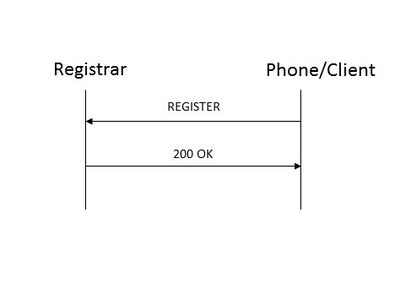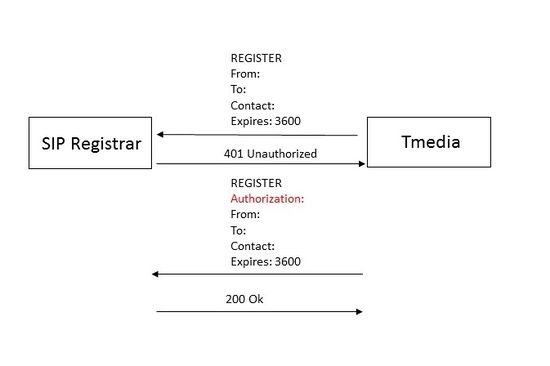SIP Registration
William Wong (Talk | contribs) |
William Wong (Talk | contribs) |
||
| Line 20: | Line 20: | ||
[[Image:Tmedia SIP Registration Process with Expires.jpg|600px]] | [[Image:Tmedia SIP Registration Process with Expires.jpg|600px]] | ||
| − | [[Image:Tmedia SIP Registration Process with Authorization.jpg| | + | |
| + | [[Image:Tmedia SIP Registration Process with Authorization.jpg|550px]] | ||
Revision as of 22:55, 7 April 2016
Contents |
SIP Registrar
A registrar is a SIP endpoint that accepts REGISTER requests and places the information it receives in those requests into a location service for the domain it handles. The location service links one or more IP addresses to the SIP URI of the registering agent. The URI uses the sip: scheme, although other protocol schemes are possible, such as tel:. More than one user agent can register at the same URI, with the result that all registered user agents receive the calls to the URI.
SIP registrars are logical elements, and are commonly co-located with SIP proxies. But it is also possible and often good for network scalability to place this location service with a redirect server.
Tmedia does not support a registrar, so for example, a SIP phone client cannot register to a Tmedia. If clients send SIP requests and responses directly to the other clients in point-to-point mode and not through a proxy, REGISTER is not required. In this case, clients are required to know the IP addresses of all the other clients they wish to communicate with.
Registration
- Registration is when Tmedia sends a SIP REGISTER to a Registrar, and gets a response which could be accepted (200 OK) or refused (anything else) that may require further action
- If Authentication is required, the registrar returns a 401 Unauthorized response with a WWW-Authenticate header
- The WWW-Authenticate header contains nonce to encrypt user’s communications password, and then the user sends a second REGISTER containing an Authorization header in which the user's encrypted password
- Even if there is no call on the system, Tmedia will send SIP REGISTER
- If it is not registered already, the Tmedia will send SIP REGISTER at 5 seconds interval, otherwise it is at the half of the minimum registration negotiated with the remote proxy (endpoint)
- The SIP REGISTER is "valid" for 3600 seconds
- Tmedia will send a new REGISTER (to refresh a registration) after half of the minimum registration negotiated, general use will be at 1800 seconds (3600/2)
- Sending SIP REGISTER will happen when the option "Register to Proxy?" is selected for a specific SIP NAP
- If you apply a new configuration and the option "Register to Proxy?" is present it will start sending SIP REGISTER
Polling
- In Tmedia, option "Poll Remote Proxy?" is enabled by default
- Tmedia SIP polling is using SIP OPTIONS method to "poke" a SIP Network Access Point (NAP) to see if it's alive or not, that is, NAP availability
- Upon a response from the SIP NAP, Tmedia will determine whether to mark the NAP as up
- If the option "Map any response to available status" is unchecked, only a 200 OK to a SIP OPTIONS will bring the NAP up
- The first time a SIP NAP is added in configuration and configuration activated, Tmedia polls at 5 seconds, after that and general use is polling at 60 seconds
Network Access Point (NAP) Availability
If "Poll Remote Proxy?" and "Register to Proxy?" are both checked, only the SIP OPTIONS answers will affect the NAP availability.
Configuration
- Allocating a SIP NAP Configuration v2.9
- Allocating a SIP NAP Configuration v2.8
- Allocating a SIP NAP Configuration v2.7
- Allocating a SIP NAP Configuration v2.6
- Allocating a SIP NAP Configuration v2.5


